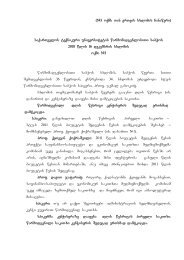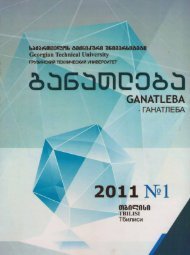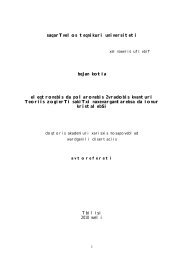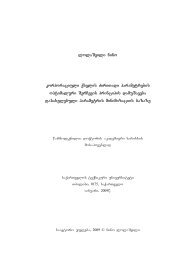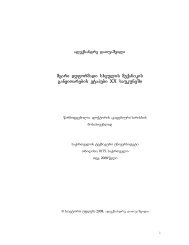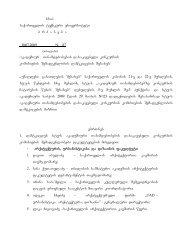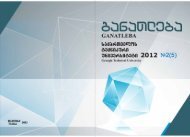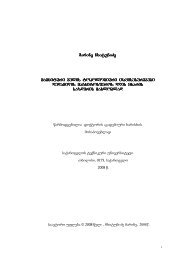Sromebi 2 (14) Works 2 (14) ТÑÑÐ´Ñ 2 (14) - Newsletters
Sromebi 2 (14) Works 2 (14) ТÑÑÐ´Ñ 2 (14) - Newsletters
Sromebi 2 (14) Works 2 (14) ТÑÑÐ´Ñ 2 (14) - Newsletters
You also want an ePaper? Increase the reach of your titles
YUMPU automatically turns print PDFs into web optimized ePapers that Google loves.
filologia – Филология – Philology <strong>Sromebi</strong> – TRANSACTIONS – ТРУДЫ № 2 (<strong>14</strong>), 2009plied to a wide range of political, ethic and moral points (12). It is considered that, practical argumentationin the trial process may vary according to the case-criminal case or a civil case.Peculiarity of the argumentation in legal discourse is not uniformity of addressee, but just therole of the third part. In the argumentation during the trial process the addressee “bifurcate”; if theplaintiff argues, then the receiver becomes the defendant and the judge, when the judge reads outthe judgment, in fact he has two receivers, plaintiff and defendant. In the confrontation the judgebecomes the third part.Cognitive psychology is interested in studying the peculiarities and style of the judge and defenselawyer’s thinking. It was determined that famous prosecutors make their speech according tothe situation, to the time and place of the trial process. Defense lawyer’s speech is always directedto the audience.According to the essence of the argumentation, judge should also take into considerationmany aspects of the situation distinguishing strong and weak one. The judge should know well thesystem of the precedent to the case. Much depends on how the judge “sees” the case and how authorizedhe is. The authoritative inclination of the personality exerts influence to the final judgment(<strong>14</strong>). A number of factors were put forward by the former judge of the Supreme Court of USA N.C.Benjamin. He includes here the judgments of the analogues cases, the constitution of the state, history,traditions and purpose of trial process and pragmatic consequences of the judgment (<strong>14</strong>).Consequently, legal argumentation should submit the rules of rhetoric. The law, the right andrhetoric are treated in a wide sense as notions concerning all the areas of the human activity.Therefore the working idea of the law is not restricted only with the narrow sphere of jurisprudence.Symbiosis of the legal practice and rhetoric as an art of making speech before the audiencecounts more than two thousand years practice. Even Aristotle noted the necessity of the rhetoricalargumentation in the court room. Cicero perhaps became the striking example who successfullycombined the ability of judge with that of orator. The speech of the distinguished jurists at the courtwas considered a kind of the argumentative discourse. The concept ional procedures, models of argumentationare considered to be adopted from the jurisprudence.Concluding remarksArgumentation is the total sum of arguments and also is the means of bringing these argumentsforward for basing some statements with the object of persuading the addressee to their admissibilityor sufficiciency in a concrete situation. The success of the argumentation is determinedwith the degree of influence over the addressee and achievement of consent between the communicators.General rules of argumentation include three kinds of maxims: rationality ,tactics and persuasiveness.The specificity of argumentation as a form of communicative process and a speech activityis defined with the conflict situation. In analyzing an argumentative discourse, we assume thatthe discourse is basically aimed at resolving a difference of opinion and that the argumentation andevery other speech act performed in the discourse with a view of resolving the difference can be regardedas a part of critical discussion.Knowledge of the basis of the theory of argumentation allows modern jurists a possibility• To see and resolve different language mistakes• To disprove not-grounded arguments of the opponents• To select preferable argumentative methods• To control and evaluate the dialogical situation as a whole25




